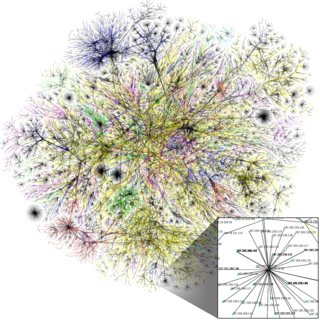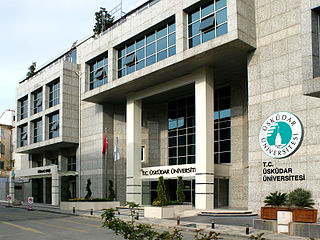
A blog is an informational website consisting of discrete, often informal diary-style text entries (posts). Posts are typically displayed in reverse chronological order so that the most recent post appears first, at the top of the web page. In the 2000s, blogs were often the work of a single individual, occasionally of a small group, and often covered a single subject or topic. In the 2010s, "multi-author blogs" (MABs) emerged, featuring the writing of multiple authors and sometimes professionally edited. MABs from newspapers, other media outlets, universities, think tanks, advocacy groups, and similar institutions account for an increasing quantity of blog traffic. The rise of Twitter and other "microblogging" systems helps integrate MABs and single-author blogs into the news media. Blog can also be used as a verb, meaning to maintain or add content to a blog.
The blogosphere is made up of all blogs and their interconnections. The term implies that blogs exist together as a connected community or as a social networking service in which everyday authors can publish their opinions and views.
Following a crackdown on Iranian media beginning in 2000, many Iranians turned to weblogging to provide and find political news. The first Persian language blog is thought to have been created by Hossein Derakhshan,, in 2001. Derakhshan also provided readers with a simple instruction manual in Persian on how to start a blog. In 2004, a census of blogs around the world by the NITLE found 64,000 Persian language blogs. In that year the Islamic government also began to arrest and charge bloggers as political dissidents and by 2005 dozens of bloggers had been arrested.
A vlog, also known as a video blog or video log, is a form of blog for which the medium is video. Vlog entries often combine embedded video with supporting text, images, and other metadata. Entries can be recorded in one take or cut into multiple parts. Unlike a more general video diary, vlogs are often recorded depicting the maker throughout.

Heather Brooke Armstrong was an American blogger and internet personality from Salt Lake City, Utah, who wrote under the pseudonym Dooce. She was best known for her website dooce.com, which peaked at nearly 8.5 million monthly readers in 2004 before declining due to various factors including the rise of social media; she had actively blogged from c. 2001 until her death by suicide in 2023.
The Mormon blogosphere is a segment of the blogosphere focused on issues related to the Church of Jesus Christ of Latter-day Saints.

The Foundation for Biomedical Research (FBR) is an American nonprofit organization, 501(c)(3), located in Washington, DC. Established in 1981, the organization is dedicated to informing the news media, teachers, and other groups about the need for lab animals in medical and scientific research. The organization, together with its partner, the National Association for Biomedical Research (NABR), argues that promoting animal research leads to improved health for both humans and animals.
Fashion blogs are blogs that cover the fashion industry, clothing, and lifestyle related topics.

Babble was an online magazine and blog network targeting young, educated, urban parents. Their site operated a large network of parent blogs, employing many bloggers on the subjects of parenting and child-raising.
ScienceBlogs is an invitation-only blog network and virtual community that operated initially for almost 12 years, from 2006 to 2017. It was created by Seed Media Group to enhance public understanding of science. Each blog had its own theme, speciality and author(s) and was not subject to editorial control. Authors included active scientists working in industry, universities and medical schools as well as college professors, physicians, professional writers, graduate students, and post-docs. On 24 January 2015, 19 of the blogs had seen posting in the past month. 11 of these had been on ScienceBlogs since 2006. ScienceBlogs shut down at the end of October 2017. In late August 2018, the website's front page displayed a notice suggesting it was about to become active once again.
While the term "blog" was not coined until the late 1990s, the history of blogging starts with several digital precursors to it. Before "blogging" became popular, digital communities took many forms, including Usenet, commercial online services such as GEnie, BiX and the early CompuServe, e-mail lists and Bulletin Board Systems (BBS). In the 1990s, Internet forum software, such as WebEx, created running conversations with "threads". Threads are topical connections between messages on a metaphorical "corkboard". Some have likened blogging to the Mass-Observation project of the mid-20th century.

South London and Maudsley NHS Foundation Trust, also known as SLaM, is an NHS foundation trust based in London, England, which specialises in mental health. It comprises four psychiatric hospitals, the Ladywell Unit based at University Hospital Lewisham, and over 100 community sites and 300 clinical teams. SLaM forms part of the institutions that make up King's Health Partners, an academic health science centre.
Trevor William RobbinsCBE FRS FMedSci is a professor of cognitive neuroscience and the former Head of the Department of Psychology at the University of Cambridge. Robbins interests are in the fields of cognitive neuroscience, behavioural neuroscience and psychopharmacology.

The National Core for Neuroethics at the University of British Columbia was established in August 2007, with support from the Canadian Institutes of Health Research, the Institute of Mental Health and Addiction, the Canada Foundation for Innovation, the British Columbia Knowledge Development Fund, the Canada Research Chairs program, the UBC Brain Research Centre and the UBC Institute of Mental Health. Co-founded by Judy Illes and Peter Reiner, the Core studies neuroethics, with particular focus on ethics in neurodegenerative disease and regenerative medicine, international and cross-cultural challenges in brain research, neuroimaging and ethics, the neuroethics of enhancement, and personalized medicine.
An anonymous blog is a blog without any acknowledged author or contributor. Anonymous bloggers may achieve anonymity through the simple use of a pseudonym, or through more sophisticated techniques such as layered encryption routing, manipulation of post dates, or posting only from publicly accessible computers. Motivations for posting anonymously include a desire for privacy or fear of retribution by an employer, a government, or another group.
Paul S. Knoepfler is an American biologist, writer, and blogger. He is a professor in the Department of Cell Biology and Human Anatomy, the Genome Center, and the Comprehensive Cancer Center at the University of California, Davis School of Medicine. In 2013, Knoepfler was named one of the 50 most influential people in the stem cell field.

George Paxinos AO DSc FASSA FAA FRSN FAHMS is a Greek Australian neuroscientist, born in Ithaca, Greece. He completed his BA in psychology at the University of California at Berkeley and his PhD at McGill University in Montreal, Canada. After a postdoctoral year at Yale University, he moved to the School of Psychology of the University of New South Wales in Sydney, Australia. He is currently an NHMRC Senior Principal Research Fellow at Neuroscience Research Australia and Scientia Professor of Medical Sciences at the University of New South Wales.

Üsküdar University is a university in Üsküdar, Istanbul, Turkey. It is the first thematic university of Turkey in the field of Behavioral Health and Sciences. It was founded by the Human Values and Mental Health Foundation.

Bethany Brookshire is an American science journalist. She writes for Science News for Students.

James David Jentsch is an American neuroscientist. He is a SUNY Disinguished Professor and Chair of the Department of Psychology at Binghamton University. His research considers the neurobiological origins of psychoses and addiction. Jentsch was awarded the 2011 AAAS Award for Scientific Freedom and Responsibility.









